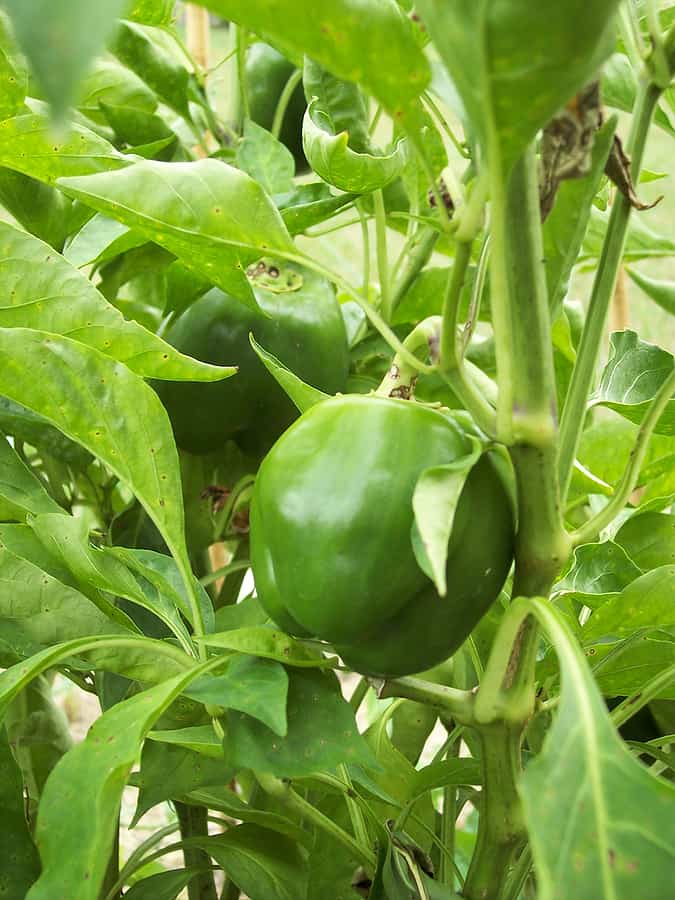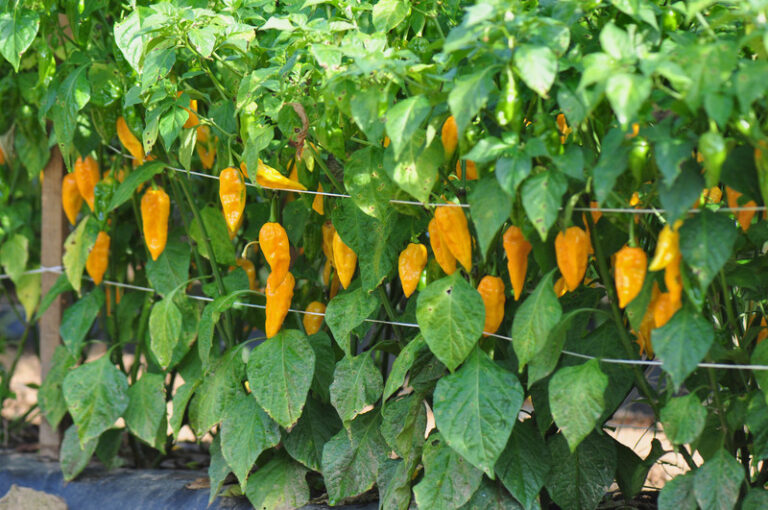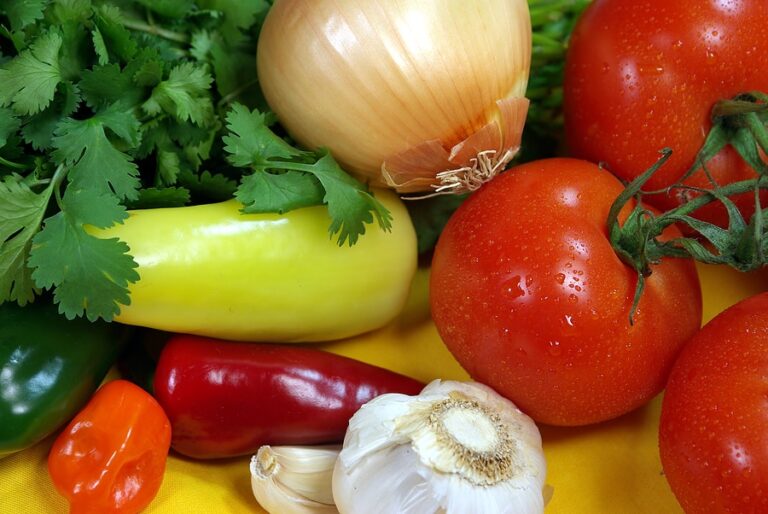Pepper Seed Starting: Proven Method for Strong, Healthy Plants
Starting peppers from seed is one of my favorite parts of gardening. There’s something satisfying about watching tiny seedlings grow into productive plants that thrive in the summer heat. After years of trial and error—figuring out which varieties germinate best, how to keep seedlings from getting leggy, and what soil mix leads to strong root systems—I’ve fine-tuned a method that consistently produces healthy pepper plants.
Whether you’re growing sweet bell peppers, spicy jalapeños, or rare heirloom varieties, starting from seed gives you more options and better control over plant health. In this guide, I’ll walk you through the steps I use to ensure high germination rates, sturdy seedlings, and a smooth transition to the garden. With the right approach, you’ll have vigorous pepper plants ready to produce a bountiful harvest all season long.
Understanding Pepper Growing Basics
Peppers are a tender, warm-weather crop. Start peppers indoors 8 to 10 weeks before the average last frost. Plant to set young pepper plants outdoors after nighttime temperatures are expected to stay above 60°F (16°C).
Start pepper seeds indoors up to 14 weeks before the last spring frost if you plan to harden off seedlings under cover outdoors before transplanting them to the garden. Peppers can be hardened off and transplanted under the protection of a plastic tunnel before the last frost. They must be kept warm.
Set peppers in the garden without protection after nighttime temperatures are consistently greater than 60°F (13°C)—unless you plan to protect them from the chill under a plastic tunnel or row covers.
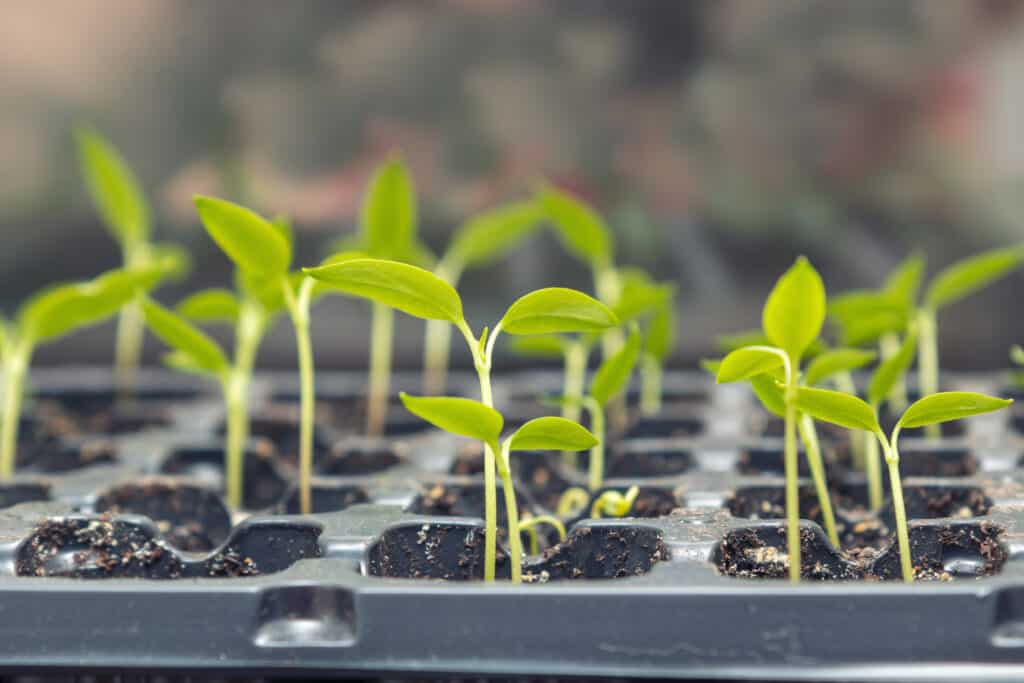
Detailed pepper growing tips: How to Plant, Grow, and Harvest Peppers.
Types of Peppers
There are two basic kinds of peppers: sweet and hot. Sweet peppers are mild in flavor; they include bell peppers. Hot peppers are pungent and range in flavor from spicy to extremely hot.
Peppers ripen to red, yellow, orange, purple, and brown depending upon the variety.
Peppers mature in 55 to 80 days from transplanting. Seedlings ready for transplanting—whether you start them yourself or buy them at a garden center—will be about 40 to 50 days old. That means peppers from sowing require 90 to 140 days to reach maturity depending on the variety.
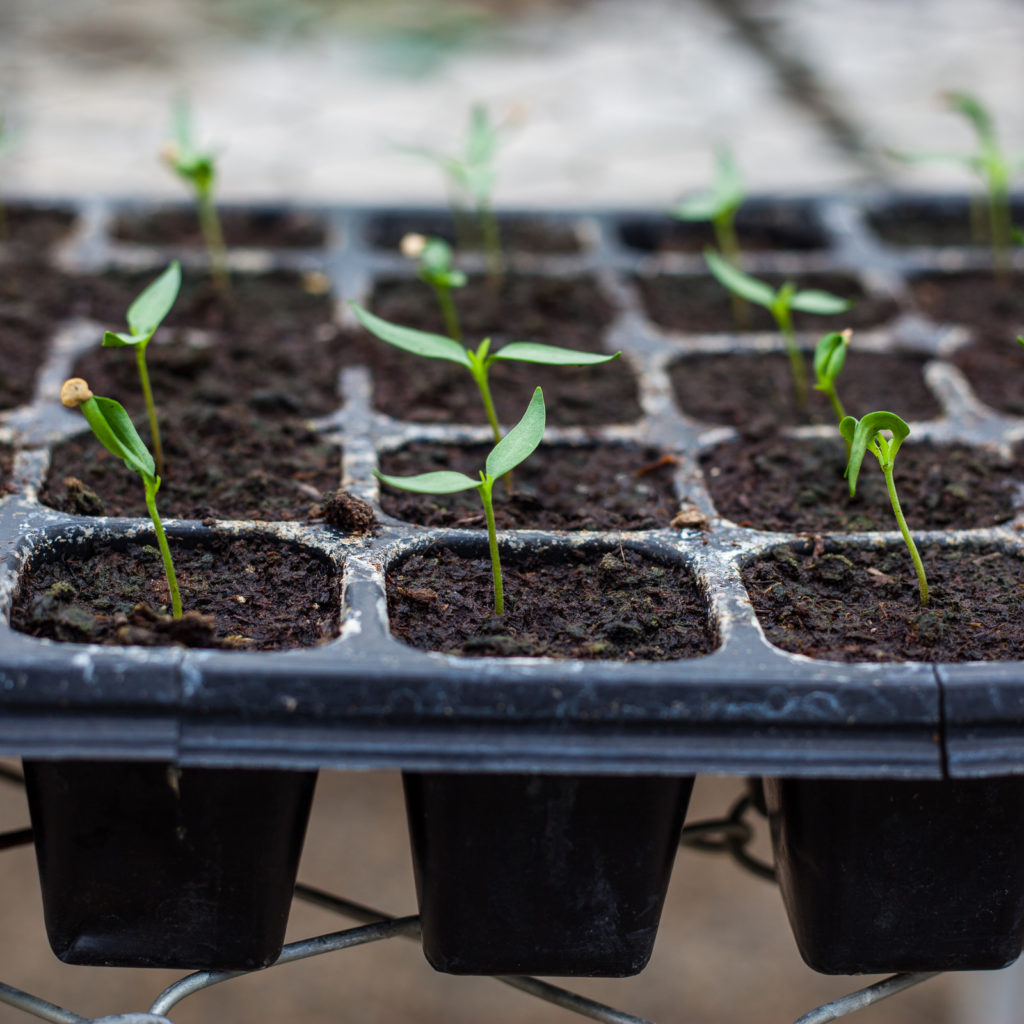
Pepper Seed Sowing
- Grow from seeds or seedlings.
- Pepper seeds are viable for 2 years.
- Peppers are commonly started indoors in a greenhouse or warm, well-lit sunroom or kitchen.
- Sow peppers in individual pots of light potting mix 6 to 8 weeks before you intend to set plants out.
- Do not set peppers outdoors until the nighttime temperature is consistently greater than 55°F (13°C)—unless you plan to protect the plants from chill under a plastic tunnel.
- Sow 3 to 4 seeds to a pot or across flats; then clip away the weaker seedlings once the strongest seedling is about 2 inches (5 cm) tall.
- Sow seed ¼ to ½ inch (7-13 mm) deep.
- Germination soil temperature is 75-95°F (24-35°C); the optimum soil temperature for germinating seed is 85°F (29°C). Seeds will germinate in about 7 days at 80°F. Use a heat mat to provide bottom heat to speed germination.
- Keep the seed starting mix just moist until seedlings emerge.
- Pepper seed can be sown directly in the garden if the soil temperature is warm enough—and there are enough days in the season for plants to reach maturity.
- Germination takes 7 to 10 days at 85°F (29°C) or warmer.
Care of Pepper Seedlings
- Seedlings started indoors should be kept under grow light or in a sunny window after germination. Keep the indoor nighttime temperature above 62°F (17°C).
- Water to keep the seed starting mix from drying.
- Fertilize with fish emulsion or a soluble complete fertilizer at half strength.
- Transfer seedlings to a larger container once they are 2 to 4 inches (5-10 cm) tall; be sure that seedlings have sufficient room for root growth. This process is called “potting up”; continue to pot up seedlings as they outgrow containers—until they are transplanted into the garden or a very large container.

Transplanting Pepper Seedlings Outdoors
- Transplant peppers after they are at least 4 to 6 inches (10-15 cm) tall into medium-rich garden soil 24 inches (60 cm) apart in rows at least 24 inches apart.
- Harden off seedlings for two weeks before transplanting them into the garden or containers outdoors. Set young plants for a few hours each day to harden them off; increase the time outdoors each day.
- Add aged compost to planting beds in advance of transplanting.
- Peppers prefer a pH range of 5.5 to 6.8.
- Grow peppers in full sun for the best yield.
- If you plant seedlings started by another grower, select plants 6 to 8 weeks old; usually in a 4-inch (10 cm) pot. Check the bottom of the pot to be sure roots are not growing through and the plant is not root-bound.
Caring for Peppers Outdoors
- Avoid planting peppers where tomatoes, potatoes, or eggplants have grown recently.
- Fertilize with an organic fertilizer such as fish emulsion at half strength.
- Protect early plants from cold weather under lightweight spun poly row covers supported by wire hoops. Cold nights will cause blossoms to drop producing bushy plants without peppers.
- Keep wire hoops—tomato cages will work—in place through the growing season to protect brittle branches from injury or breaking.
- Common pest enemies include aphids, Colorado potato beetles, flea beetles, tomato hornworms, and others.
- Common diseases include blossom end rot, bacterial spot, and soft rot.
Interplanting Peppers
- Interplant peppers with bush beans, chives, cucumbers, lettuce, marigolds, eggplant, and tomatoes.
Container Growing Peppers
See this article: 7 Tips for Growing Peppers in Pots
Pepper Planting Calendar
- 10 to 14 weeks before last spring frost: start seed indoors for transplanting into a plastic tunnel.
- 8 to 10 weeks before the last frost in spring: start seed indoors for transplanting into the garden.
- 2 to 4 weeks before last spring frost: transplant seedlings into a plastic tunnel to harden off.
- 2 to 3 weeks after the last spring frost: transplant hardened-off seedlings into the garden; minimum soil temperature is 60°F; protect plants from nighttime temperatures below 55°.
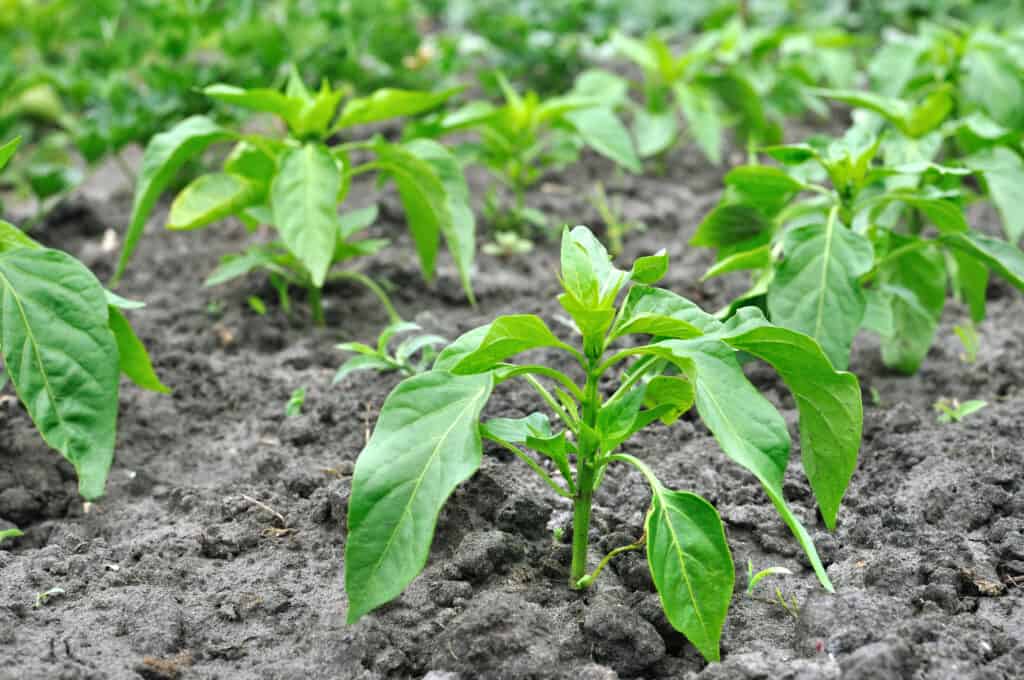
Types of Peppers
There are two basic kinds of peppers: sweet and hot.
- Sweet peppers are mild in flavor; they include bell peppers. Hot peppers are pungent and range in flavor from spicy to extremely hot.
- Hot peppers are commonly measured for their hotness in what are known as Scoville heat units; be sure to test a pepper low on the Scoville unit scale before trying hotter peppers.
Botanical Name: Capsicum annum (mostly sweet peppers), Capsicum chinense, Capsicum frutescens (hot or chili peppers).
Peppers are a member of the Solanaceae family, other members of this family are tomatoes, eggplants, and potatoes.
🌶 Peppers Growing Hub
Start here:
- How to Plant and Grow Hot Peppers: A Gardener’s Guide to Spicy Success
- How to Grow Sweet Peppers: A Gardener’s Guide to a Bountiful Harvest
Getting Peppers Started (general prep)
- Seed Starting Peppers: Proven Method for Strong, Healthy Plants
- Soil Preparation for Peppers: The Secret to Strong Roots and Big Harvests
- Best Hot Pepper Varieties to Grow for Salsas, Sauces, and Drying
- Best Sweet Pepper Varieties to Grow
- World’s Hottest Peppers You Can Grow in Your Garden
- The Science of Pepper Heat: Understanding Scoville Units
- Growing Peppers Indoors Under Lights
- Companion Planting with Peppers: Best and Worst Neighbors in the Garden
Planting & Growing Peppers
- When and How to Transplant Pepper Seedlings Outdoors
- 10 Steps to Grow a Bumper Pepper Crops
- How to Grow Hot Peppers in Containers: Tips for Small Spaces
- 7 Tips for Growing Peppers in Pots
- How to Grow Colored Bell Peppers: How to Get Reds, Yellows, and Oranges
- Cross-Breeding Hot Peppers at Home: A Beginner’s Guide
- How to Water & Fertilize Sweet Bell Peppers for Maximum Yield
- Pruning Pepper Plants for Healthier Growth and Bigger Harvests
- Six Tips to Grow Peppers for Flavor
- Pepper Season Extension & Overwintering: How to Keep Plants Producing Longer
Pepper Care & Troubleshooting
- Pepper Pests, Diseases, and Problems—How to Fix Them Naturally
- Caring for Peppers: Mid-Season Problem Cures
- How to Increase the Heat of Hot Peppers Naturally
- Overwintering Pepper Plants Indoors
- How to Overwinter Pepper Plants in Any USDA Zone
Harvesting & Preserving Peppers
- When to Harvest Hot Peppers for Maximum Heat
- How to Harvest Sweet Peppers for the Best Flavor
- How to Preserve Hot Peppers: Drying, Fermenting & Pickling
- How to Ripen Green Peppers Indoors
- Saving Pepper Seeds for Next Year’s Crop
Cooking & Using Peppers
- Preparing and Serving Sweet Peppers – Harvest to Table
- Five Ways to Cook and Serve Chili Peppers
- Stuffed Peppers: Best Varieties for Cooking
- Cooking with Hot Peppers: Flavor & Safety Tips
- How to Handle Hot Peppers Without Burning Your Skin
Books to help you grow:


